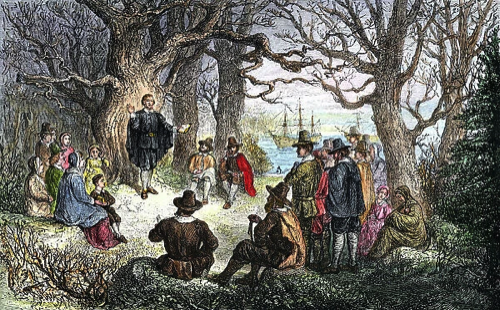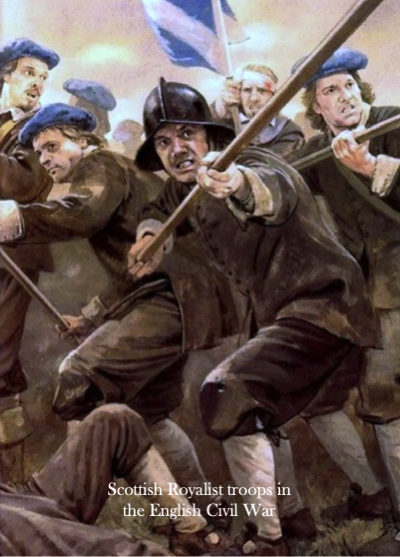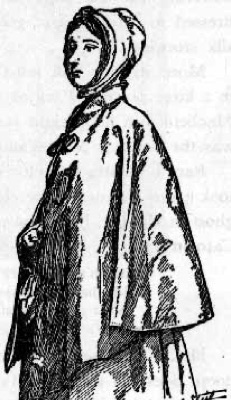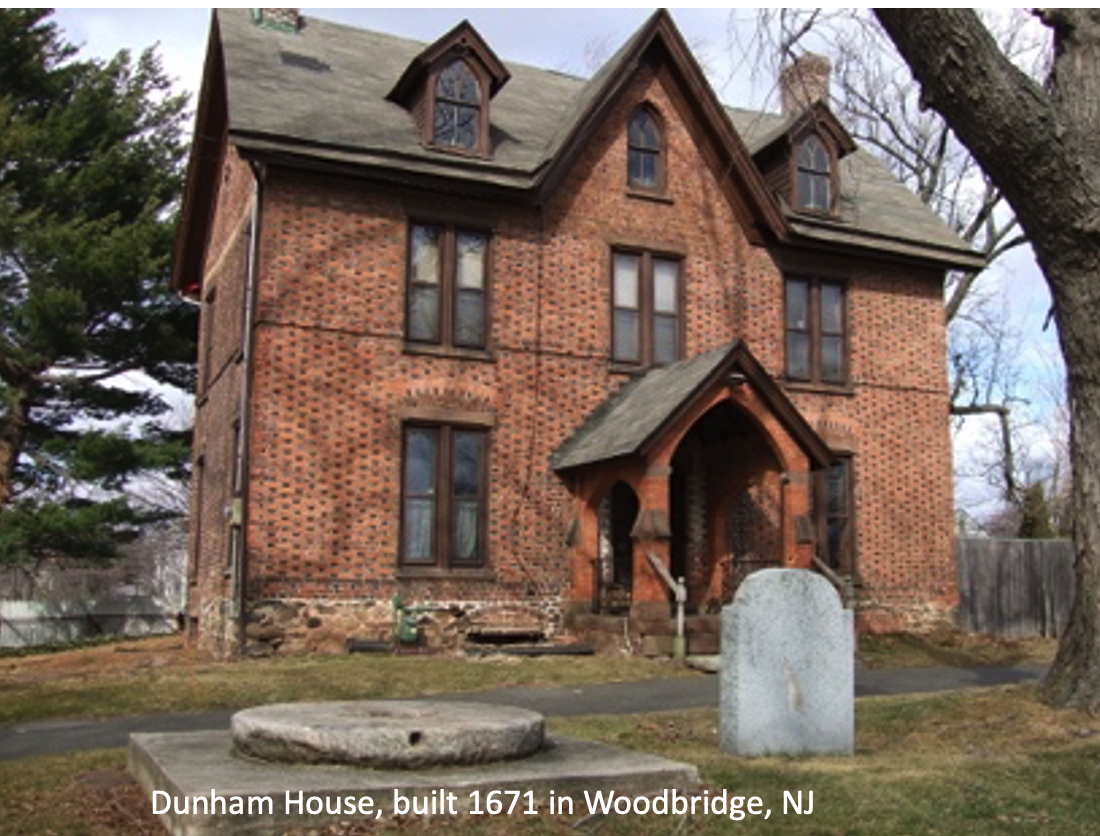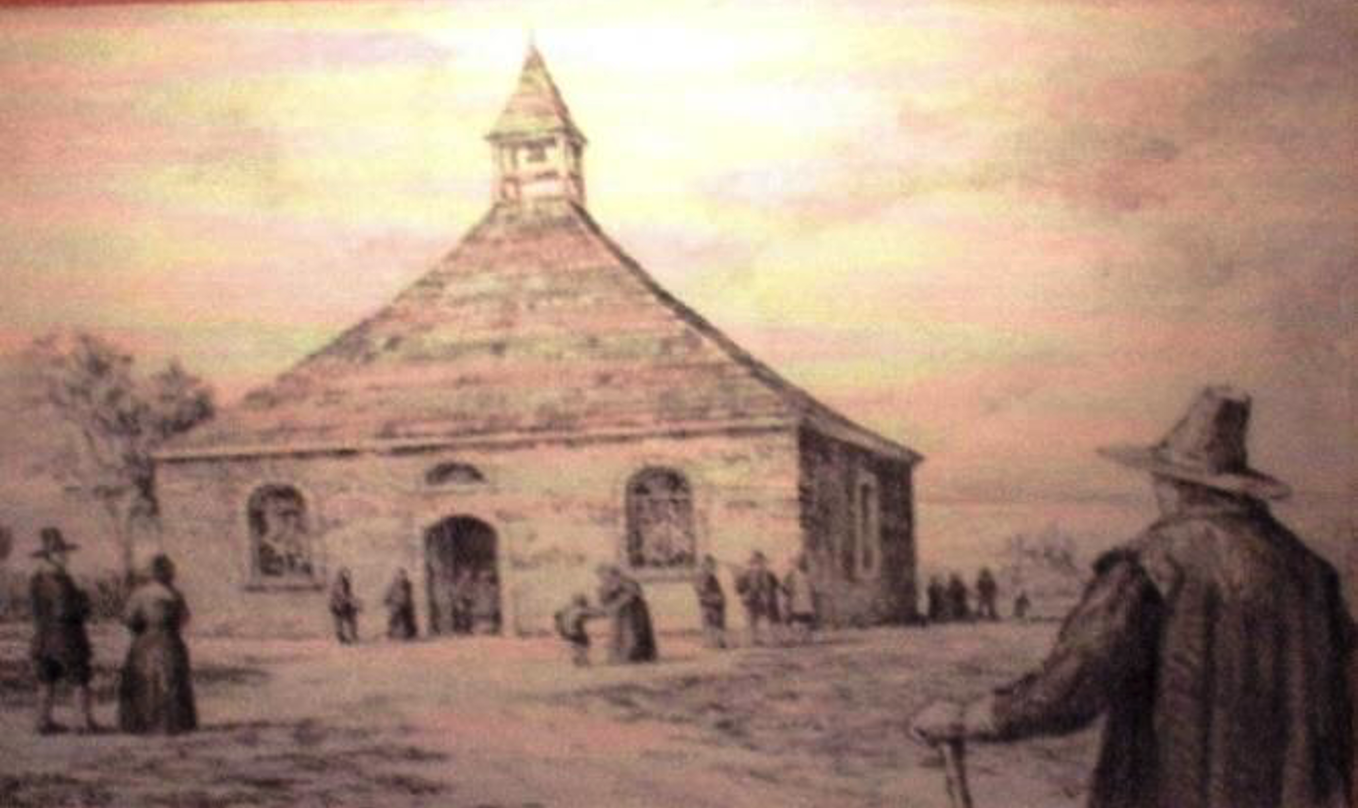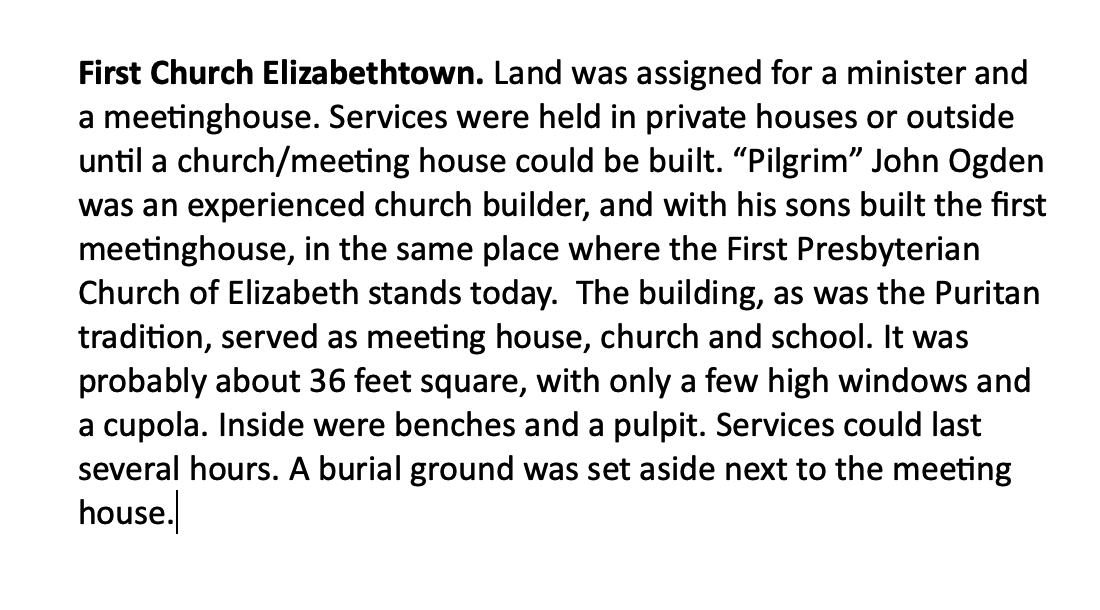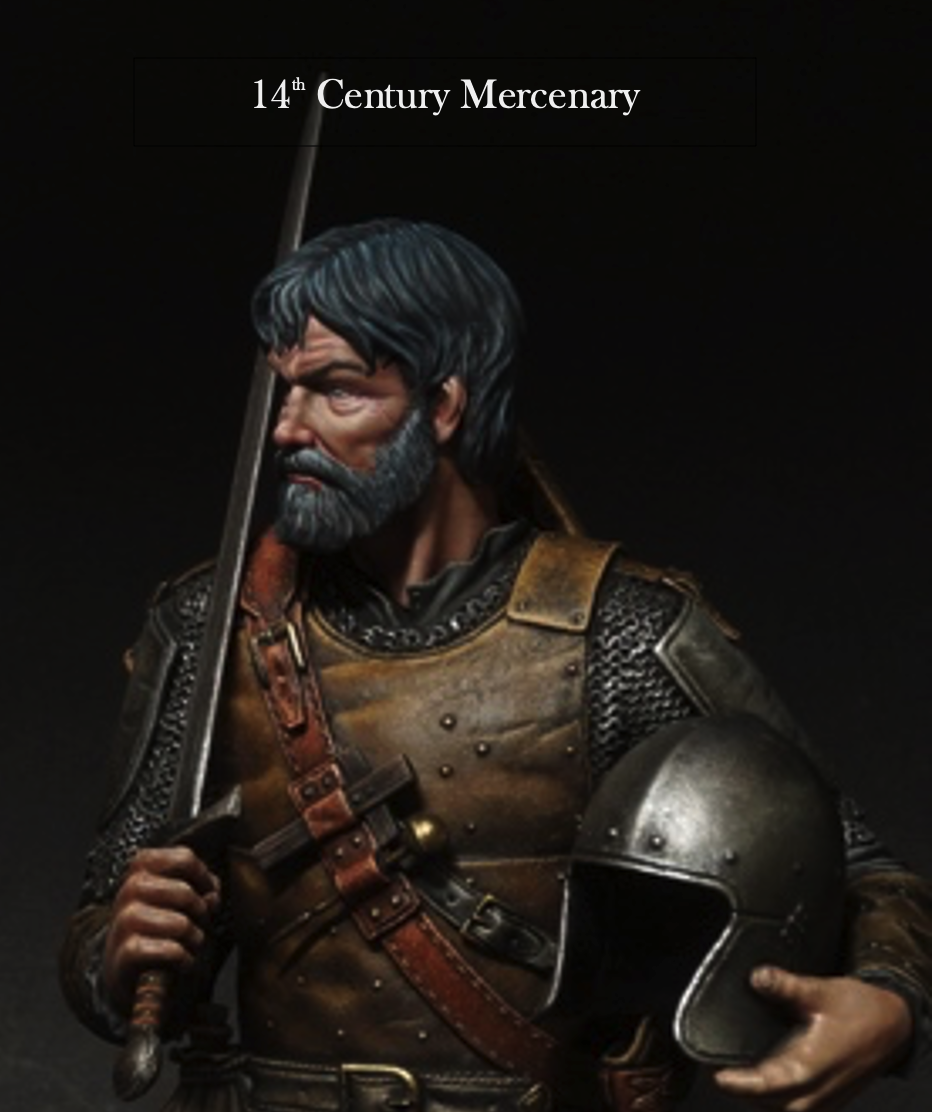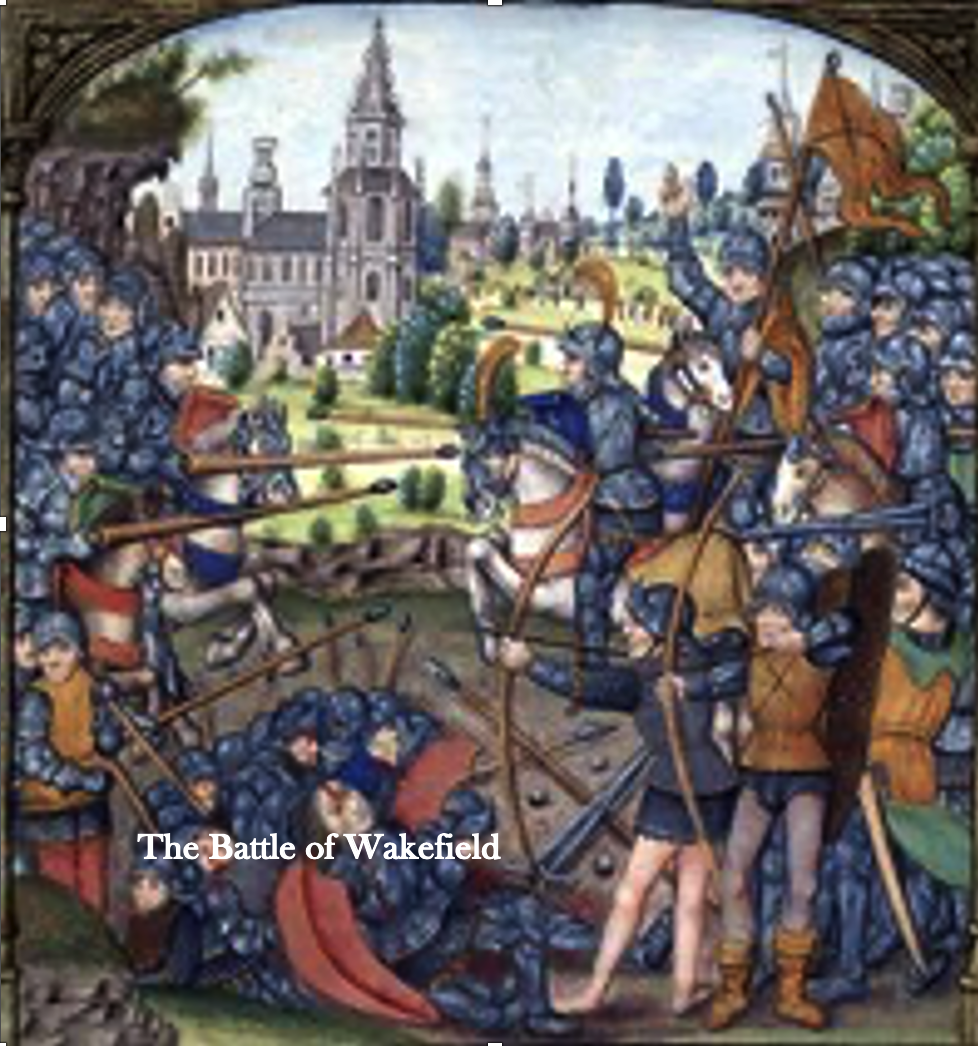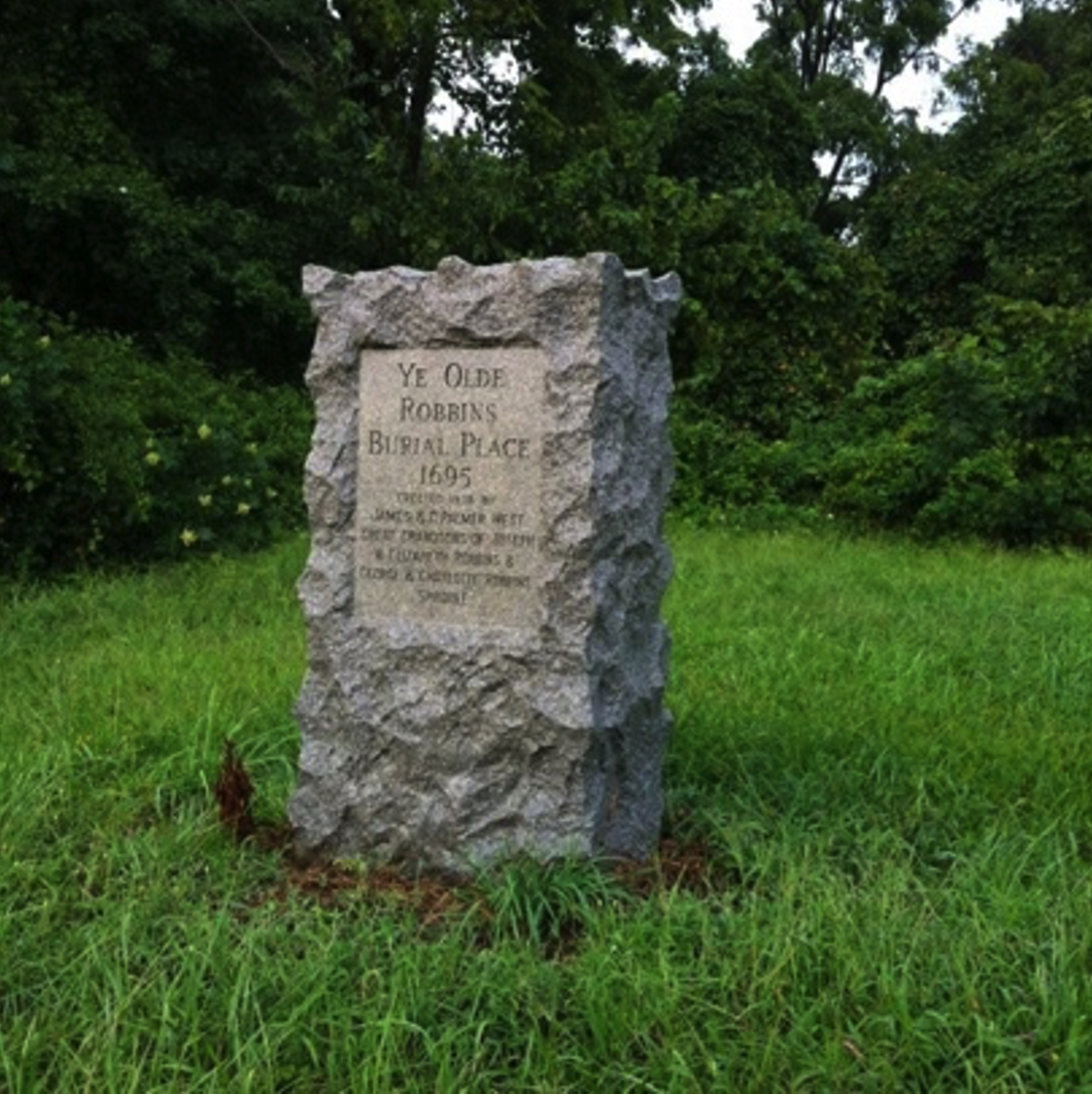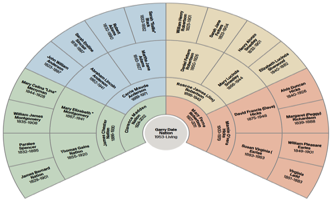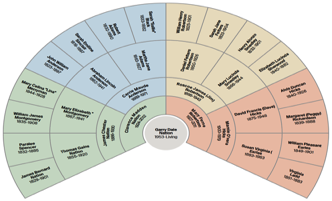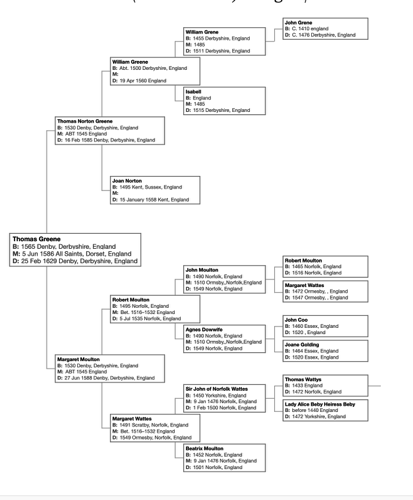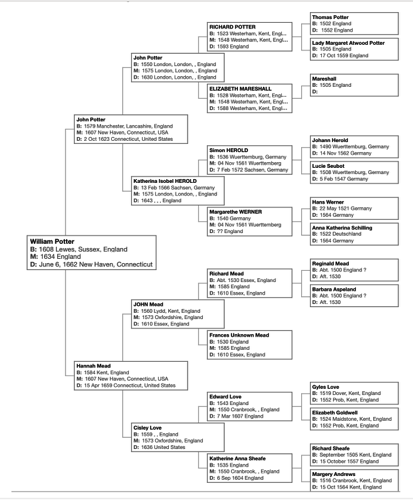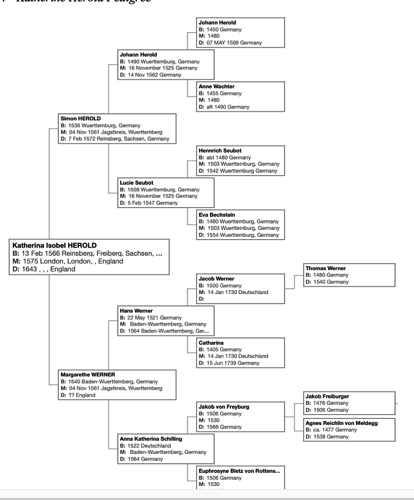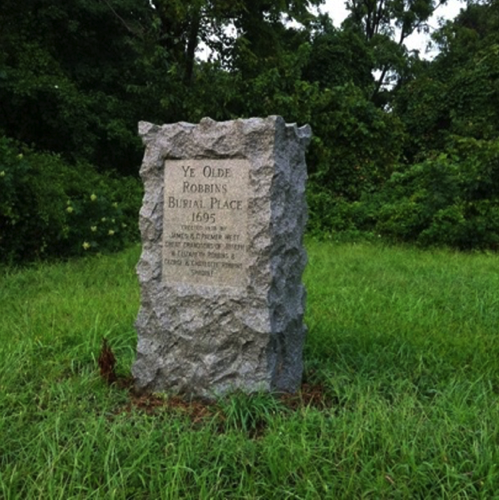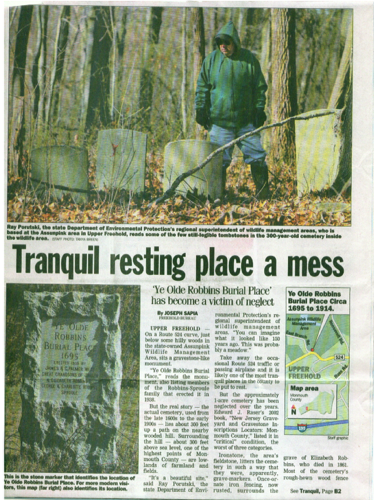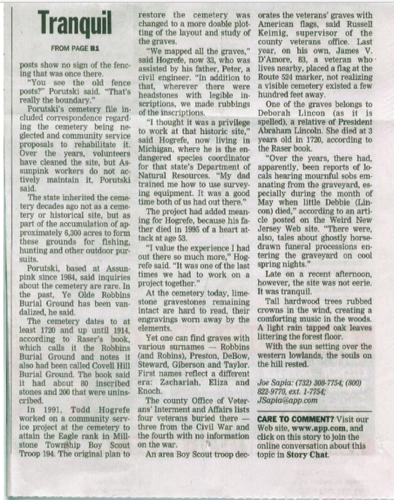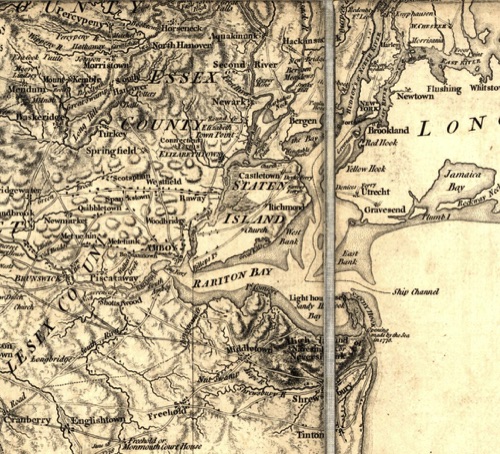
1
From North Petherton to North America
The untimely death of her husband in 1703 placed Frances Parsons Nation in a dire situation. Charged with the care of a young boy and an elderly woman, the youthful widow's support system was discouragingly thin. Her marriage removed her far from her own home and family. The family she had married into had deep generational roots in the Somerset village of North Petherton, but the family tree had not weathered well of late. Her deceased husband had no living parents or siblings. His closest surviving relatives were his great uncles, Christopher and Henry Nation, now in their fifties. Even with help from this small extended family, the weight of being a breadwinner must have fallen hard upon Frances's young shoulders. We don't know what she did to try to make ends meet and put food on the table, but it appears that she struggled to do so in North Petherton for three years or so before a new opportunity presented itself. It was both costly and risky. She would sell herself and her young son into servitude in exchange for passage to America.
That, at least, appears to me the most likely scenario in view of the facts we know. We have documentary evidence of young John Nation as an indentured servant in New Jersey. There is an apocryphal story that John was kidnapped and sold into slavery. This is possible but such kidnapping was rare, there is no specific evidence for it, and it simply does not fit with other facts, chiefly that his mother and great grandmother also came to New Jersey around the same time. Their transit is not documented, but Nation family genealogists are unanimous that both of the women died in the colonies and not in North Petherton.1 It is hard to imagine how these two poor widows would find a way to make the expensive voyage without some leverage.
How then might this transaction have taken place? At some point, Frances had contact with a broker who offered her passage for herself and her family in exchange for a term of service at labor. Indentured servitude was common in the American colonial period and was the vehicle for many Dutch and English immigrants to come to the colonies. One way it was promoted, for example, was the Headright System through which colony organizers offered incentives of acreage for every laborer brought in by a grant owner to work the land and increase the population. Although indentured service declined with the rise of chattel slavery, it continued in America well into the 1800s.
The indentured servant was technically not property owned by his master, but his labor was, and his contract was a good that could be bought, sold, or passed on to one's heirs. His living conditions and the nature of his service, like those of a slave, were entirely according to the good pleasure of the master, who was legally obligated only to feed and shelter him. Unlike slavery, however, his situation was contractual and more-or-less voluntary. The usual term of service was five or six years, although it could be extended if circumstances called for it—including if the one under bond tried to escape. The contract of indenture had a limited term, after which the servant would be freed from his obligations, assuming he lived so long. There was no stigma attached to having been a bondservant, and once released he was free to make of himself whatever he could. Until then, though, he had no right to leave the master's employment for any reason—even mistreatment. Neither had he (or she) any right to marry without the master's permission.2
We assume, then, that Frances made contract for herself and possibly also her son John (there were no child labor laws) to give service to someone in New Jersey colony in exchange for transport and living arrangements for the two of them and for John's great-grandmother, Elizabeth Till Nation. This was probably around 1707 when John was 10, Frances 29, and Elizabeth about 80. Frances was young and presumably could look forward to a life of possibilities after her period of servitude—even a new marriage, for there were many more men than women in the colonies at this time.
It is unlikely their accommodations on the transatlantic voyage were better than bearable, more likely the opposite. If the weather was favorable the journey took about six weeks. If it turned bad it could take two or three months. Illustrating the hazards of sea travel, 1707 was coincidentally the year of the weather-related Scilly Naval Disaster, one of the worst maritime disasters in British history.3
Assuming a typical route, the Nation family's ship sailed from the Somerset port of Bristol to New York Harbor. They likely disembarked in Manhattan and were ferried across the Hudson to New Jersey.
We have no record of their early days in the colony, how they found their places, or when they parted ways. Nation family genealogists have traced Elizabeth Till Nation to St. Mary's, Maryland, where she added another decade to her life before she died February 8, 1817 at the remarkable age of 90. How and why she got there or with whom she dwelt remains a mystery. Perhaps there were relatives with whom she made connection, but at this writing I do not know what evidence places her there at that time.
1 Ancestry Family Trees. Neither is there evidence or documentation of their death and burial in North Petherton or anywhere else in England.
3 On October 22, 1707, 4 ships of the Royal Navy ran aground and sank near the Isles of Scilly near Cornwall in Great Britain. All 4 ships were lost with almost all hands: an estimated 1550 British sailors were lost, including the fleet commander, Admiral Sir Cloudesley Shovell. Only 13 sailors survived. https://www.historyandheadlines.com/history-october-22-1707-scilly-naval-disaster-was-not-a-silly-naval-disaster/
3
The Elizabethtown Connection
In 1644 a group of English settlers founded their first settlement in New Jersey on the west bank of Newark Bay opposite Staten Island, land purchased from the Lenni Lenape Indians. They called it Elizabethtown,1 not for the late queen as we might suppose but for the wife of Sir George Carteret, one of the proprietors. They were Puritans of “moderate religious views,” meaning that they were more tolerant than the Puritan establishment in New England and that membership in the church was not required in order to own land or vote.2
Elizabethtown's significance to us is as the New World home of two families from whom came Anna Pack, the mother of Bethiah Robins.
William Peck (or Pack) and Grace Green
William Peck (b. 16 Dec 1610) and Grace Green (b. 24 Oct 1619) were born and raised in Lowdham, Nottinghamshire, England. William was the grandson of Robert Pecke (1546-1593) of Beccles, Suffolk, a member of the gentry (the landed class just below the nobility) and a wealthy man holding much property in East Anglia.
William's mother Katherine Perse (1599-1614) died when he was only four, and his father ten years later when he was 14. In 1633 at age 23 he married young Grace—very young, only 14. The following year their first child George was born in Nottingham, England.3 Then in 1635 her father, Thomas Greene passed away in Yorkshire.
In 1637 William and Grace immigrated with young George to America. We have no story for why they left their home in England but note that here as in so many cases the departure occurred after the death of parents. In William's case, though, there likely were more positive reasons. He is called “a merchant from London” in one record, and his coming to America may not have been for lack of opportunity so much as expansion of his earning ability, for there was much profit to be made. In that same record he is called “Deacon William Peck of New Haven” indicating his place as a leader in the church there.5
They settled in Elizabethtown, New Jersey accompanied by Grace's mother, also named Grace. Grandmother Grace had the colorful maiden name Nutter—and it apparently means what we think it means. Her father Peter of Bingley, Yorkshire (1565-1612) was known dually as Nutter and Wild, a descriptive surname he seems to have earned. We do not know anything about his parents or anything more about him. Perhaps he was an orphan who grew up on the street as a “wild child”; or he was just one of those singular people for whom society does not have a place or role; or he was truly mentally ill.
Grace's father Thomas Greene had a far more illustrious background extending back to knights of the realm, including at least one who accompanied William the Conqueror. Among the most notable though were John Coo (Coe) and Sir Richard Wattys (Watts).
John Coo, Soldier of Fortune
John Coo (b. about 1340) was a professional soldier who rose to knighthood fighting in the White Company, that famous band of English soldiers-of-fortune immortalized in the novel by A. Conan Doyle. A survivor of wars and battles in Italy, he was granted lands in Gestingthorpe, Essex where he retired, settled his family, founded his estate, and lived to the age of 65, a remarkably long life for someone of his profession. Among his later descendants was the Puritan Robert Coe, the principal founder of the Coe family in America. But for our family there was a different connection through the daughter of his great-great-grandson and namesake, John Coo (b. 1460).7
Sir Richard Wattys (Watts)
Sir Richard (b. 1410), of Norfolk, was a supporter of Richard, Duke Duke of York in his unsuccessful effort to wrest the kingdom from the pious but weak-minded King Henry VI. He was killed at the Battle of Wakefield, one of the great decisive battles of the Wars of the Roses, on December 30, 1460. Sir Richard is one of our 18th great-grandfathers. Thomas (b. 1433), his son by Lady Isabel Strafford, continued his line through Lady Alice Beby (1440-1472) with sons who attained knighthood once again. But it was their daughter Margaret Wattes (1476-1547) who entered our family line when she married her cousin Robert Moulton of Ormesby St. Michael, Norfolk (1465-1516)—our 16th great-grandfather. Their first son John Moulton (1490-1549) took for his wife Agnes, the daughter of John Coo (1460-1520) and Joan Golding (1464-1520). Robert and Margaret Moulton had a daughter they named Margaret for her mother (1530-1588). Margaret Moulton married Thomas Norton Greene (1530-1585) of Derbyshire, the great-grandfather of Thomas Green of Bingley, Yorkshire who married Grace Nutter—the parents of Grace Greene who married William Pecke, our American immigrant ancestor.8 And William and Grace were the parents of George Pack.
George Pack and Anna Elizabeth Cranmer
George Pack (note the fluidity between the names Peck/Pecke/Pack/Packe), father of Anna Pack and maternal grandfather of Bethiah Robins, was one of the founding citizens of Elizabethtown. He is listed in its records and is represented as a historical character in the pageant celebrating the city's heritage.9 Jack Randall Crawford and Mary Porter Beegle, The Pageant of Elizabeth, Second Regiment Armory, October 28, 1914. The pageant was first performed in 1914. He had his own tract of land, a total of 118 acres, and worked it as a yeoman farmer. In 1665 he signed the oath of allegiance. In 1700 he signed a remonstrance to the King asking for the appointment of a competent governor.10
The woman he married, Anna Elizabeth Cranmer, also has a stout English heritage, but on her mother's side.
Little is known of the background of Anna Elizabeth's father William Cranmer (or Cramer).11 It appears William was born in 1620 at Newton Abbot, Devonshire, and departed for American shores as a youth. He married 24-year-old Elizabeth Carwithy (or Carwithen) in Southold, Suffolk, New York in 1640—the same year the town was founded. William, a carpenter, dwelt in his Long Island home for over 20 years before removing to Elizabethtown where he took the oath of allegiance and fidelity on February 19, 1665. Perhaps there were reasons of family tragedy that prompted the move. There is but one child to show for the prime childbearing years of his marriage to Elizabeth (Anna, b. 1641); but three sons were born to them in Elizabethtown (Thomas, b. 1662, William, b. 1664, and John, b. 1666).12 The record also shows he attained a measure of prominence there.
He attached himself to the governor's party and seems not to have been numbered with the Town Associates. He was appointed town constable April 27,1670 and served till October 13, 1671. He became possessed of various tracts of land amounting to 209 acres besides the town lot of six acres on which he lived. His name is on record as frequently buying and selling land.13
It was their oldest child Anna who, on June 8, 1692 at the comparatively advanced age of 29, married 22-year-old Joseph Robins.14 Joseph was the son of Daniel Robins and Hope Potter.
1 The present Elizabeth, New Jersey, the Union County seat and fourth largest city in the state.
2 “Elizabethtown - the First English Church,” Descendants of Founders of New Jersey (www.njfounders.org)
3 The American Genealogical-Biographical Index [Gen. Column of the " Boston Transcript". 1906-1941: 9 Feb 1934, 7916] lists his birthplace as New Jersey, but it is unlikely that the Packs had made it to the colony by then. The Millennium File and Find A Grave Index are surely correct to identify his birthplace as England.
4 Ancestry Family Trees. England, Births and Christenings, 1538-1975 (Salt Lake City, Utah: FamilySearch, 2013)
5 North America, Family Histories 1500-2000: The Baldwin Genealogy, from 1500 to 1881 (Provo, UT: 2010). That same record also names Peck's wife as Elizabeth, not Grace.
6 See below, Exhibit #2, Thomas Greene Pedigree.
7 Bartlett, J. Gardner. Robert Coe, Puritan, his ancestors and descendants, 1340-1910: with notices of other Coe families. Boston: Bartlett, 1911. However, one researcher disputes the “myth” of Sir John Coe. Admitting his service under Sir. John Hawkwood in Italy, he disputes his elevation to knighthood. http://paulsancestors.eu5.org/johncoe.htm
8 Ancestry Family Trees
9 A. Van Doren Honeyman, ed. History of Union County, New Jersey, 1664-1923 vol. 1 (NY: Lewis Historical Publishing Co., 1923), p. 20. Wm. Nelson, ed., Patents and Deeds and Other Early Records of New Jersey, 1664-1703 (Reprinted: Genealogical Publishing Co. Baltimore:1976, 1982).
10 Ancestry.com, History of Union County, New Jersey, 1664-1923 (Provo, UT: Ancestry.com).
11 He shares the name of the central figures of the Protestant Reformation in England and some have tried to make a family connection, but it is not to be found. Some early clues in my research suggested that he was the son of Edmund Cranmer, Archdeacon of Canterbury who was in the thick of the English Reformation alongside his brother Thomas Cranmer, the Archbishop of Canterbury under Henry VIII who was martyred by Queen Mary. Many family genealogists have attached that line, but those clues proved to be false leads and the facts do not add up. As it turns out, we don't know whose son William was.
12 Francis Bazley Lee, ed., Genealogical and Memorial History of the State of New Jersey: A Record of the Achievements of Her People in the Making of a Commonwealth and the Founding of a Nation (New York: Lewis Historical Publishing Co., 1910), 134.
13 Ibid.
14 Family Data Collection - Individual Records (Edmond West, comp., Ancestry.com).
4
The Potters
Hope Potter, born February 3, 1641 in New Haven, Connecticut, was the daughter of William Potter1 and Frances Child (1609-1663)2 who immigrated to America from Sussex, England.
On June 4, 1635, 27-year-old William Potter embarked with his 26-year-old wife Frances Child Potter and their 4-month-old son Joseph on the Abigail for Boston.3 An educated Puritan, he became a fairly well to do landowner, settling first in Watertown, Massachusetts, then moving to New Haven Colony in 1639, where he was joined by his widowed mother and younger brother John that same year. William and Frances had six children, their fourth being a daughter, Hope. William was a reputable citizen, active in the community, and a member in good standing of the First Church of Christ in New Haven.
He was, that is, until he was accused by his wife and one of his sons—to the consternation of the whole community—of the sin and crime of having unnatural relations with animals. When first questioned by the authorities, he seemed shocked by the accusation and vigorously denied it. But the magistrates were unsatisfied and turned the investigation over to church authorities and the Deputy Governor. Under further questioning, Potter's conscience got the better of him, and he confessed to a practice that began when he was a boy of eleven and continued off and on with a variety of beasts, even after seeing others executed for committing similar acts. Unfortunately for him, in Puritan New England his was a capital offense, and he was hanged on June 6, 1662.4
Before he died, William left a will providing for his wife so long as she remained a widow and un-remarried, leaving her care and most of his estate to his son Nathaniel, 18. He also assigned a legacy to each of his daughters—"20th apiece payd ym when their mother sees good to pay it them,” but that it should “be payd out of the farms before it comes into my sonne Nathanll's hands.” Apparently, the widow and son were slow to fulfill their duties as executors, because on April 7, 1663 his daughters had to file a lawsuit over the matter before they could receive their assigned share of the estate.5
In the meantime, one of those sisters met the man who would take her away from the unhappy history of this place and relocate to New Jersey Colony. In New Haven on February 10, 1663, at age 22, Hope Potter was joined in marriage to an indentured servant who tended livestock, a 36-year-old Scottish exile, short in stature with blue eyes, dark curly hair, and a thick Gaelic accent. His name was Daniel Robinson, later to be called Daniel Robins.6
1 William Potter was born in 1605 in Lewes, Sussex to John Potter (b. 1550 in Manchester, Lancashire) and Hanna Mead Potter (b. 1584, Kent). Hannah Mead was the daughter of John Mead and Cicely Love, both of whose family lines ran at least to three generations in Kent, England. The Potter ancestry may point to landed gentry (possibly descended from Sir Thomas Potter, d. 1522, and Lady Margaret Atwood Potter, d. 1559) who perhaps lost some of their property and influence in the turbulence of the 16th and 17th centuries, but at this writing that lineage is difficult to verify. John Potter's mother Katherina Herold (b. February 2, 1566) also has a history for which we wish more information. An immigrant to England from Reinsberg, Saxony (East Germany), her family roots are traced back to Freiburg in the Black Forest and perhaps to people of title and land (von Freiburg, von Rotweil, von Meldegg). Her father apparently died in Germany, and she may have accompanied her mother to England. But what her history is and why she left Germany and settled in England we do not presently know. See below, Exhibit #4, Katherine Herald Pedigree.
2 Frances Child's mother's name was Jane. Presently that is all we know about her, but we may presume she also was English. Her father Thomas, however, has a lineage in Bedfordshire, England we can possibly trace back to his fourth great-grandfather, William Childe (1448-1509) and his wife Amanda Coryyour (1449-1472). Thomas was named for his own grandfather Thomas Childe (1523-1606), who was married to Margaret Warren, the daughter of William Warren (1503-1554). Thomas's father Luke was born in Bedfordshire in 1558 but died in Lincolnshire in 1628; and his wife Susan Sell, the daughter of William Sell, was born and died in Roxton, Bedfordshire. Thomas also was born in the town of Roxton in 1592, but died in Essex, England in 1610. See Exhibit #3, William Potter Pedigree.
3 New England, The Great Migration and The Great Migration Begins, 1620-1635 (Ancestry.com, 2013); P. William Filby, ed., Passenger and Immigration Lists Index, 1500s-1900s (Ancestry.com, 2010).
4 The story of William Potter is richly documented as to his birth, immigration, citizenship, matters leading to his execution, and the disposition of his estate, most of which is collected in New England, The Great Migration and The Great Migration Begins, 1620-1635, Ancestry.com. See also Drake, Samuel G. "The Founders of New England," The New England Historical and Genealogical Register, vol. 14:4 (Oct. 1860), pp. 297-359; “At a Court of Magistrates, held at Newhaven for the Jurisdiction, the 26th of May, 1662,” Records of the Jurisdiction of New Haven. (As ignominious as was Potter's end, at least he does not bear the infamy of Thomas Granger, who was the very first colonial to be executed twenty years earlier and for similar offenses.)
5 New England: The Great Migration, op cit.
6 Sara Robins Hoffman, The Exile of Daniel Robins to America in 1652 (Dewey, AZ: Sara Robins Hoffman, 1992), 9.
5
The Life of Daniel Robins
When describing indentured servitude earlier I wrote that it was more or less voluntary. In the case of Daniel Robins, it was decidedly less voluntary. For him it was a penal commitment as a prisoner of war.
Soldier and Prisoner of War
Daniel Robinson was born near Blair Atholl, Scotland to Richard and Mary Robertson (Clan Donnachaidh) around the year 1627.1 He came of age during the period of the English Civil War in which the Puritan-run Parliament overthrew and eventually executed King Charles I.
Scotland, whose church followed Presbyterian doctrine and polity, had supported the Parliamentary revolution. However, when the Commonwealth reneged on its promise to keep the Presbyterian establishment, the Scots invited Charles's son, in exile in the Netherlands, to return to the Scottish throne, which he did in 1650. Charles II intended to use Scotland as a base to reestablish the British monarchy. Standing in his way was Oliver Cromwell whose New Model Army had defeated every Royalist force sent against him and had just completed a vicious campaign to suppress the Catholic uprising in Ireland. Turning his attention toward Scotland, Cromwell soundly defeated Charles II at Dunbar on September 3, 1650. Charles retreated and spent the next several months recruiting a new army with which he planned to march on England, rally the population he supposed was dissatisfied with Puritan rule, and re-take the throne. Daniel Robinson joined that army, 16,000 strong.
Charles's new Scottish army swiftly marched unopposed deep into the midlands of England, believing that they could catch Parliamentary forces by surprise. They were mistaken. Cromwell was well prepared and met them at Worcester with his own army of 28,000. Cromwell was used to defeating opponents who outnumbered him, but this overwhelming force made his victory the decisive—and the last—battle of the English Civil War. Charles II fled back to the Netherlands where he stayed until the Commonwealth collapsed after the death of Cromwell. 10,000 Scottish soldiers who survived the slaughter were taken prisoner. One of them was Daniel Robinson.
The prisoners were force-marched to London and made to camp in the open outdoors. The deprivation was severe. A witness described them:
...All of them [were] stript, many of them cutt, some without stockings or shoes and scarce so much left upon them as to cover their nakedness, eating peas and handfuls of straw in their hands which they had pulled upon the fields as they passed.2
The government hardly knew what to do with them all, and disease, starvation, and exposure took the lives of many. A year earlier, though, hundreds of the captured Scots from Dunbar had been deported to the colonies in America and the Caribbean to work as compulsory indentured servants—the official euphemism was “apprenticeship.” Application had recently been made by New England businessmen in need of laborers for sawmills, ironworks and such, and Daniel Robins found himself put onboard The John & Sarah for Boston along with a few hundred of his comrades, including probably a half dozen or so of his kinsmen.3 It is likely that selections for this voyage were made based on fitness for work.
It was a winter crossing, and adverse conditions led to the deaths of up to ten percent of the human cargo. The ship finally sailed into Boston Harbor in February 1652, and the men were auctioned to New England planters and mill owners for contracts of six to eight years—proceeds going to the owners of The John & Sarah.4
Indentured Servant
For many, to be sold into servitude was a doorway to destitution after their term ended, being turned out onto the streets in Boston facing prejudice and unemployment.5 For others it offered a step up as many of them married and found a way to make a life. The truly fortunate few even married into their employers' families. NEHS, op cit. But where would it lead Daniel Robinson?
According to well-preserved tradition transcribed in a descendant's diary, Daniel was purchased by Connecticut plantation owner Nathaniel Foote and taken to tend livestock on his New Haven estate. He was well treated, his work helped Foote to prosper, and he and his employer developed a mutual regard. Foote died before Daniel's term expired, but Daniel remained with the family even after the 8-years were up.6
During this time, he met and courted Hope Potter. The Potter and Foote families had a relationship: Hope's older sister Sarah married Nathaniel Foote's son Robert.7 Moreover, Daniel was undoubtedly present in New Haven during the Potter family ordeal and was aware of William Potter's infamy. None of that deterred him from asking Hope to marry him. They continued to dwell in New Haven where he continued to be known by the name Robinson, and they began to raise a family with the birth of two children, Mary and Daniel (Jr.).8
Land Owner
Upon hearing that the crown was opening up New Jersey for English settlement, Daniel applied for and received a land grant. “Other historical documents refer to Daniel Robins and his wife, Hope Potter of New Haven, as early settlers of Woodbridge, New Jersey. The original land grant, found in the New Jersey Archives, records Daniel Robins as receiving 173 acres in 1669.”9 It is unknown whether he changed his name deliberately, or whether it was an accidental change due to a clerical error of some sort, but the important thing is that he owned it and his children continued to do so after him.
Daniel and Hope Potter prospered in Woodbridge and over the years acquired a good deal of wealth, adding 200 additional acres of land to their plantation and nine more children to their family. Daniel, known locally as “The Scot” and “Scotch Robins,” served his community at various times as a tax collector, constable, and overseer of highways.10 He also indulged his passion for music, acquiring as one of his possessions a harp.11
We have no specific information as to Daniel's religious convictions. He was raised in Scottish Presbyterian Calvinism, made his home with English Puritans and prospered among them, and married the daughter of a staunch (albeit fallen) Puritan. Although he had no schooling his wife Hope was literate and read the Bible to him. It is said that he took special enjoyment in "the Old Testament Scriptures that spoke of the patriarch Joseph and the Hebrews in Egypt," and indeed he named four of his sons after Joseph, Moses, Aaron, and Benjamin.12 Perhaps he saw a summary of his own life in the words of Joseph in Genesis 50:20, “Ye thought evil against me; but God meant it unto good.”
Their last son Benjamin was born in 1686. The following year Hope Potter Robins died at the young age of 46. Daniel never remarried, but in 1695 at age 69 he purchased large tracts of land some forty miles south in Crosswicks, New Jersey. One acre of that was set apart as a family cemetery that still stands.13
While in Crosswicks he and his sons Daniel, Jr. and Moses became associated with the Society of Friends. Hoffman, Exile, His son Joseph, our own ancestor, preceded him in death in June 1709 at the age of 39 in Freehold, New Jersey. Daniel continued to live in Crosswicks, but his last days were spent in Freehold where he died August 18, 1714 at age 87. His last wish was to be buried, not in the family plot at Crosswicks, but with his beloved Hope in Woodbridge, and so his sons and daughters did the extraordinary thing and carried his remains the 28 miles to his final resting place.14
1 Sara Robins Hoffman, The Exile of Daniel Robins to America in 1652 (Dewey, AZ: Sara Robins Hoffman, 1992), 3.
2 “How Scottish POWS Were Sold as Slave Labor in New England,” NEHS (NewEnglandHistoricalSociety.com).
3 His name is registered as Daniel Robinson, but researchers have confirmed that this is the same man who identified as Daniel Robins in New Haven, Connecticut and Woodbridge, New Jersey. Hoffman writes:
Six other men, also aboard, have the same surname, most likely they were Daniel's kinsmen. Only one name, Patrick Robertson, was recorded correctly. These illiterate Scotsmen knew very little English, and spoke with an unfamiliar Gaelic accent, making it impossible for the English scribes to render a correct name spelling. It appears many of the names were spelled phonetically or given the English version.... By reviewing the names on the ship's manifest. It is possible to see the difficulties encountered by the scribes. (op. cit.6,7)
4 Hoffman, Exile, 6.
5 That circumstance led to the founding of the oldest charity in the Western Hemisphere, the Scots' Charitable Society founded January 6, 1657 by several of the former POWs for the relief of their unfortunate comrades.
6 Hoffman, 7.
7 Ibid.
8 Ibid, 8, 9.
9 Ibid, 8.
10 John W. Taylor and Sara Robins Hoffman, The Robins/Robbins of New Jersey, p. 6.
11 Will of Daniel Robins
12 Hoffman, Exile, 12.
13 See Exhibits #5a and 5b, “Ye Olde Robins Burial Place” (newspaper clipping), and Exhibit #6, Ye Old Robbins Burial Place Marker.
14 Hoffman, op. cit., 13, 14.
6
Joseph Robins
Joseph Robins, born March 27, 1670 was Daniel and Hope's fourth child, the second to be born in Woodbridge, their second son. Evidently there was commerce and communication between their family and the good folks of Elizabethtown nine miles to the north, because it is from that town Joseph chose his bride, Anna Pack, nearly six years his senior. The two were married June 8, 1692, and their first child Anna was born eight months later on February 8, 1693. Joseph built a home on his father's property in Woodbridge and lived there until 1696 when his father deeded him 100 acres of a 500-acre tract near Upper Freehold Township. There the couple lived and produced eight children. Bethiah, born in 1702, was their fifth born.1
In late spring 1709 Joseph grew seriously ill and on May 10 wrote a will in which he commended his soul “unto God who gave it”; his body “to be buried in a Christian like and decent manner... nothing doubting but at the Generall Resurrection I shall receive the same by the mighty power of God”; and concerning “such worldly estate wherewith it hath pleased God to bless me with in this life,” he apportioned out land, money, and valuables to “Anna my well beloved wife” and to his sons and daughters. To 7-year old Bethiah he bequeathed ten pounds. In the will he speaks also of an unborn child.2
He died the following June 6, and it would seem that his wife Anna, their oldest daughter Anna (16), and their three youngest children, Rachel (6), Jacob (4), and Charity (2) also died about the same time—a terrible family tragedy but not at all uncommon, for in those days fevers arose and spread without warning and could quickly claim victims. But Anna's baby, Richard, was born and incredibly survived the disease that would kill his mother. These must have been heartbreaking days for Daniel Robins and surely, he must have longed to have his beloved Hope with him to share his grief and give him comfort.
Bethiah Robins
Bethiah was about 7, brothers Nathaniel and Joseph (Jr.) were 15 and 14 years old respectively, sister Frances only 12, and Richard but an infant when they lost their parents and sisters and brother that terrible summer. Afterward, they would go to live with relatives, whether kept together or separated, and that in turn gives us insight as to why Bethiah would be eager at age 16 to marry a man in his twenties.
John and Bethiah
The only fact of the relationship between John Nation and Bethiah Robins that has been documented is the year and place of their marriage: 1718 in Freehold Township, Monmouth County, New Jersey.3 We might imagine a scenario in which these two young people may have met. There are but twenty-five to thirty miles between Nottingham in Burlington County and Upper Freehold in Monmouth County. The Nation Study notes that Edmund Beaks resided in Crosswicks at that time and that he and Daniel Robins witnessed a number of documents together. He suggests that John may have been working for Edmund here, and this may be how he met Bethiah.4
There may also have been religious connections, because we know the Beaks family were Quakers and some among the Robins clan had lately been drawn to the Quaker brand of faith. One can see how Bethiah might be drawn to a young man who, like her, had suffered the childhood loss of parents. Having been steeped in stories about her grandfather, she would not be put off by the fact that John was still bound to the Beaks family, especially since he could assure her that he was coming near the end of his term. And even if the relatives who were her foster family were kind, the teenaged orphan was probably anxious to find a new life in which she could start her own family instead of trying to fit into someone else's.
And so, the 16-year-old orphan with a 10-pound dowry (assuming she received it and was still in possession of it after being in the care of guardians) married the now grown up servant boy, and in the bonds of their matrimony the first Nation family (of our line) in America was established. Where they would go from here will be the subject of the next chapter.
1 Sara Robins Hoffman, “Joseph Robins” (2010).
2 Transcribed Will of Joseph Robins 1709, Taylor and Hoffman op cit.: 151, 152.
3 U.S. and International Marriage Records, 1560-1900 (Yates Publishing), et al. Some sources give an alternate date of 1720 and one the all but impossible date of 1710, but 1718 fits all the facts with no contradictions.
4 Stepping Forward, op.cit.
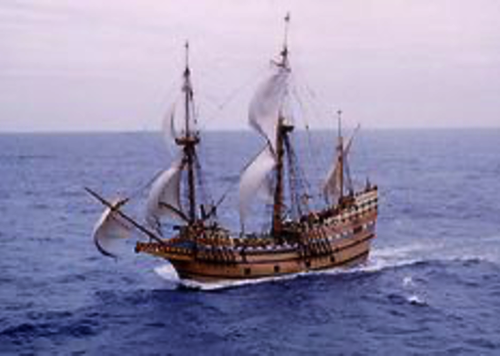
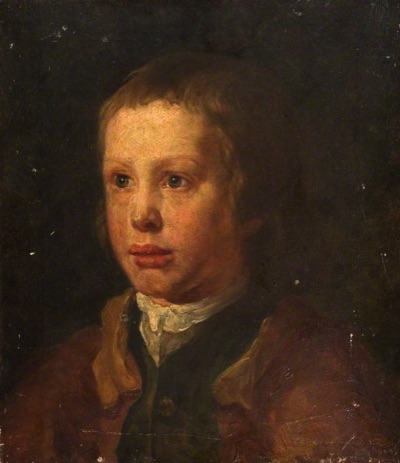
2
Servant Boy
Once they arrived in America, Frances and her son came into the employ of Mr. William Beakes (or Beaks), a yeoman farmer in Burlington County, New Jersey.
William Beakes Sr. & family headed off to the new world in 1682 to join William Penn. The inventory of his estate in 1687 fixed at £1,000 was quoted as being the largest during the first six years of the proprietary government in Bucks Co., PA.1
According to the Nation Study website, William Beakes, Jr. was born and baptized a Quaker in 1663 in Backwell, Somerset near Bristol, just three miles from Frances's birthplace of Wraxall. It is a coincidence that makes the author of the study wonder if the Parsons and Beakes families knew each other, and whether they might have made a connection before Elizabeth brought her boy to the colony.2
The Beakes family was notable in the colony.
William Beakes Jr. married his 2nd wife Ruth Stacey in 1705 (Chesterfield MM). She was a daughter of Mahon Stacey (one of the original six who founded Trenton, NJ). When Mahon Stacy and other Quakers arrived in the area in 1679, Trenton was known as "The Falls." Stacy was instrumental in establishing the Chesterfield MM in 1684, which included Friends from Crosswicks and Trenton. In 1686, Trenton Quakers organized the first local charity, which assisted Friends who had met with misfortune. Stacy contributed corn from his mill, which gave the Mill Hill area its name. After William Trent purchased land from the Stacy family in 1714, the town was finally called Trenton.3
The move to America unfortunately did not extend Frances Nation's life but shortened it. The daughter of Richard and Mary Parsons died in 1710 in Burlington County, New Jersey.4 She was only 32. Her employer William Beak(e)s, Jr. died within months of her death, and we may wonder if they both perished from the same illness. At this time Frances's young son John appears in the will of Mr. Beaks of Nottingham, Burlington County, New Jersey, registered on March 24, 1711. The summary generalizes “real and personal estate, incl. servant boy John Nation."5
When Beaks died he left to his second wife, Ruth, an estate that included his “servant boy John Nation.” In the Inventory on 27 Apr 1711, the boy, 14 at the time, still had eight remaining years indentured service valued at 17 pounds. The extended term may be because he had to assume the unexpired service of his deceased mother. In any case, his service would be completed in 1719.
Ruth Stacy inherited considerable estate from her father, and after the death of her first husband, William Beakes, purchased 100 acres of land from her stepson, Edmond Beakes, adjoining Ballifield, on which she and her second husband, Samuel Atkinson, took up their residence on their marriage September 12, 1714. They resided there a short time, removing in October 1719, to a large tract of land in Chester Twp. - This was the year John Nation was finally free to pursue his life's dreams.6
Beaks owned a farm on the east bank of the Delaware River, and we may assume that young John Nation worked primarily as a farm hand. Clearly, though, it was not his intent to stay in his master's employ, or even necessarily to remain in the Quaker community. At 21, at the end of his contract but possibly before his release date, he married, something he would have to have the permission of Mrs. Beaks or perhaps son Edmund Beaks to do.
His choice of a wife was Bethiah (b'-THY-ah) Robins, 16, of Freehold, New Jersey. It was a blessed choice, for their successful marriage anchored their family in America for generations to come.
Bethiah was a New Jersey-born, second-generation American (b. 1702), the fourth child and second daughter of Joseph Robins and Anna (sometimes referred to as Hannah) Pack, both of whom were also New Jersey natives. The Packs had immigrated from England. The Robins family line can be traced back to Clan Donnachaidh (pronounced Donna-Key) in Scotland—whose name in English is Robertson.7
This was the first intersection of the Robertsons with the Nations, and as we know, not the last. Bethiah's ancestry includes some colorful figures, some with connections to English nobility. One of Bethiah's paternal great-grandfathers is the subject of probably the greatest scandal in all our family history. But the taint of scandal did not attach itself to her, for while one man tarred his once-good name, another had taken exile from his homeland as an opportunity to make himself a man of substance.
But first we should have a look at certain of her immediate ancestors who settled in Elizabethtown, New Jersey.
1 Nation Study: Stepping Forward to 1840 in America, https://nationstudy.com/histories/step.php
2 Ibid. It is possible. It is just as possible that Beak(e)s purchased them in auction after they landed, and that perhaps his choice was partly influenced by her background.
3 Ibid. See also Genealogy of William Beaks. https://jeffsgenealogy.info/CookLine/g1/p1804.htm
4 Source: Ancestry Family Trees
5 Documents relating to the colonial, revolutionary and post-revolutionary history of the state of New Jersey. aka New Jersey Archives., 23:31.
6 Stepping Forward, op. cit.
7 Sara Robbins Hoffman, The Exile of Daniel Robins to America in 1652 (Dewey, AZ: Sara Robbins Hoffman, 1992), 1.
